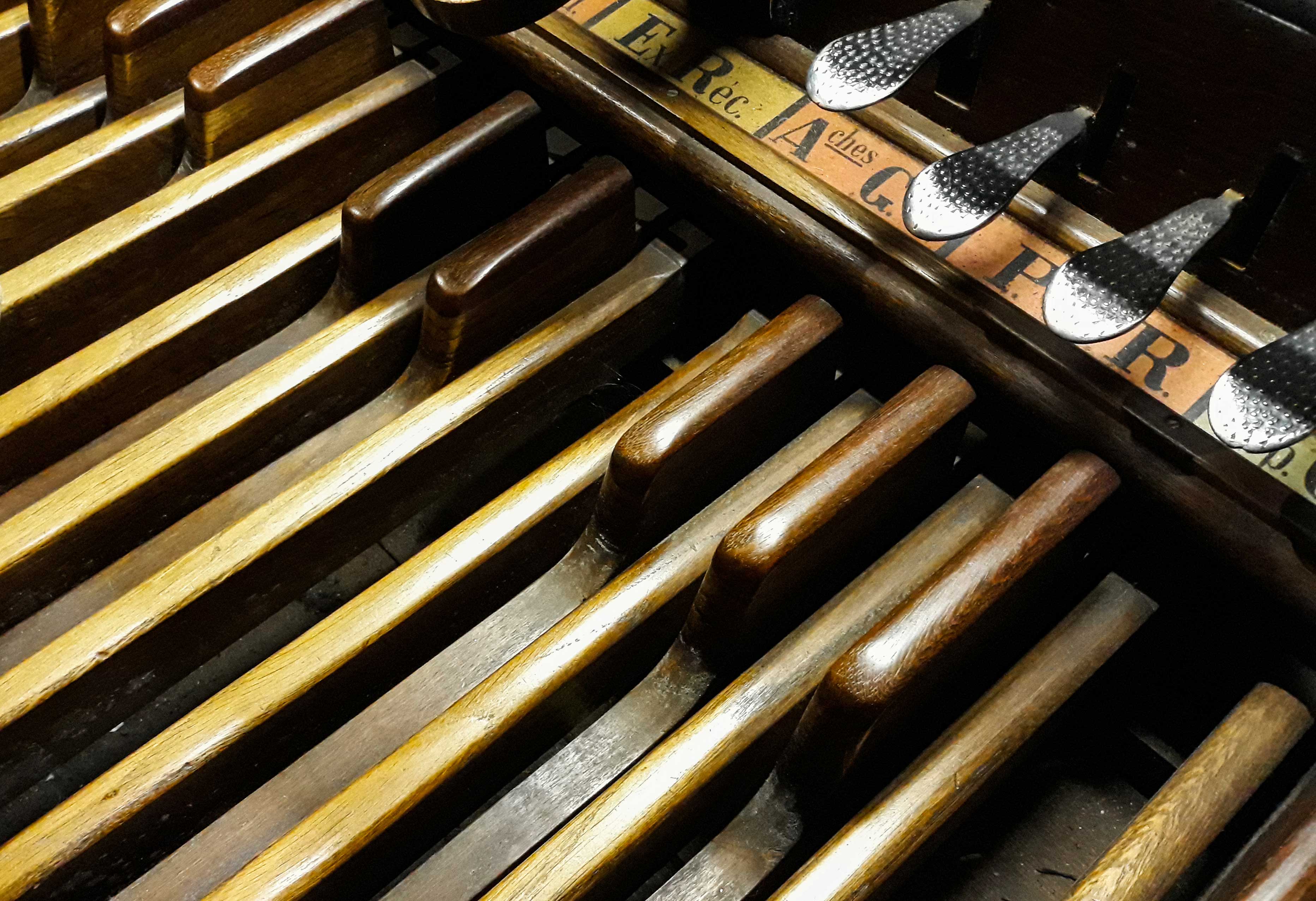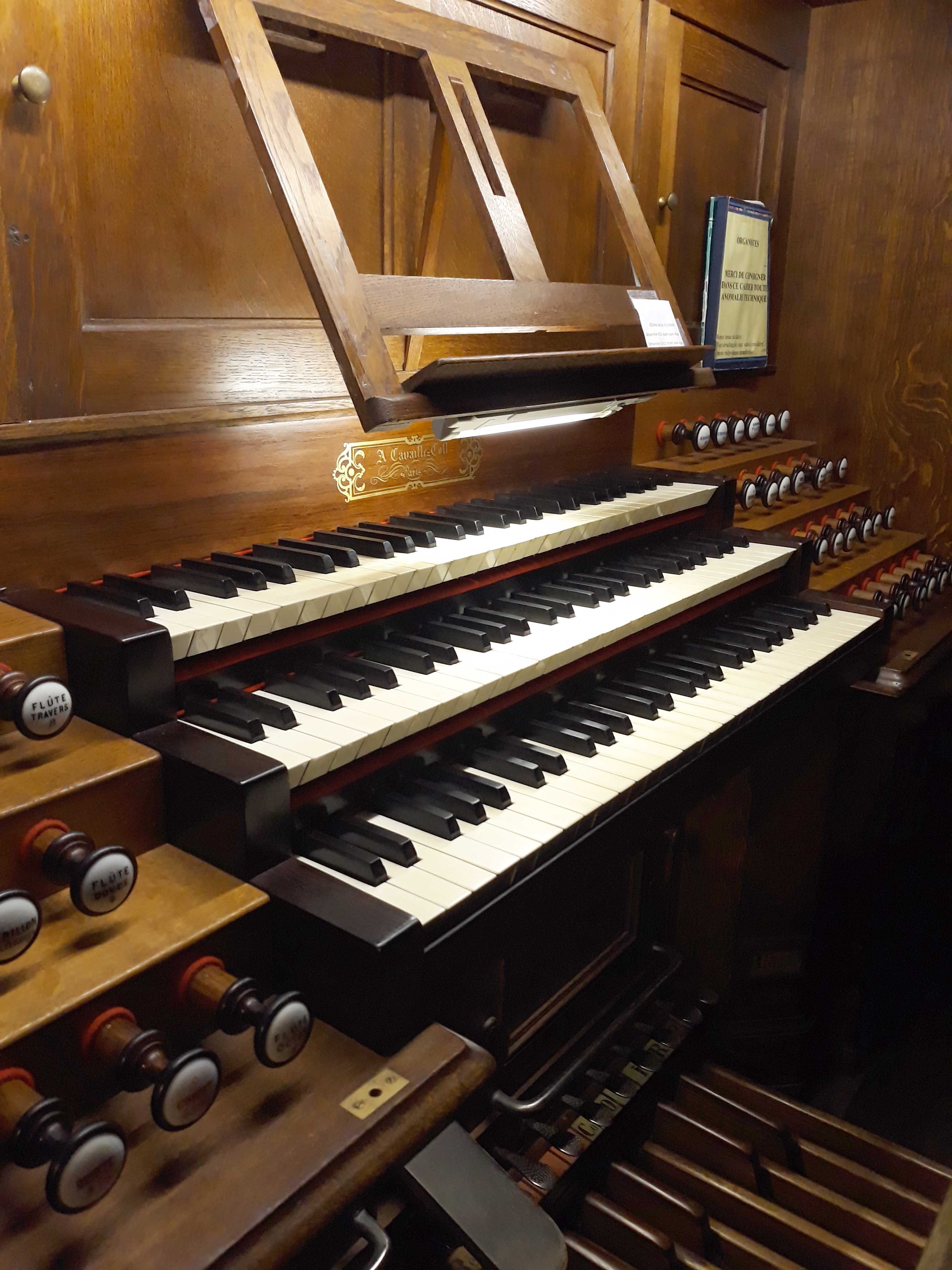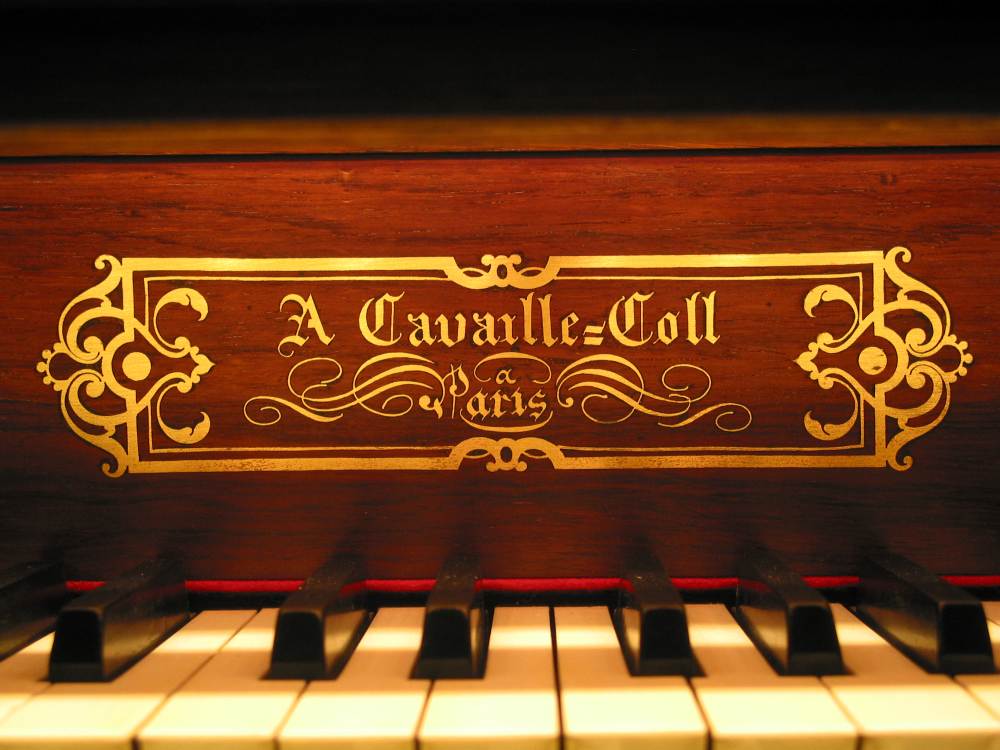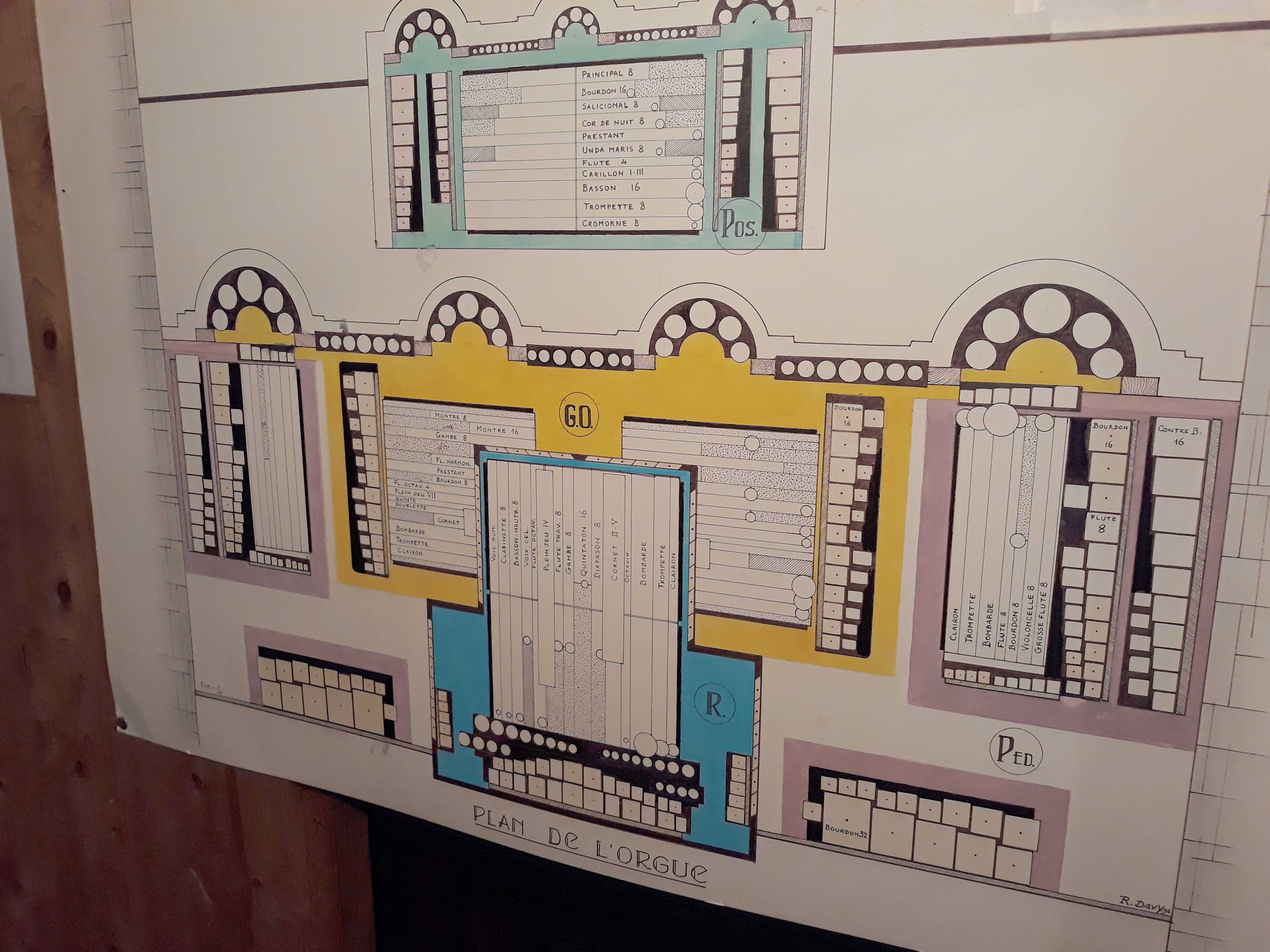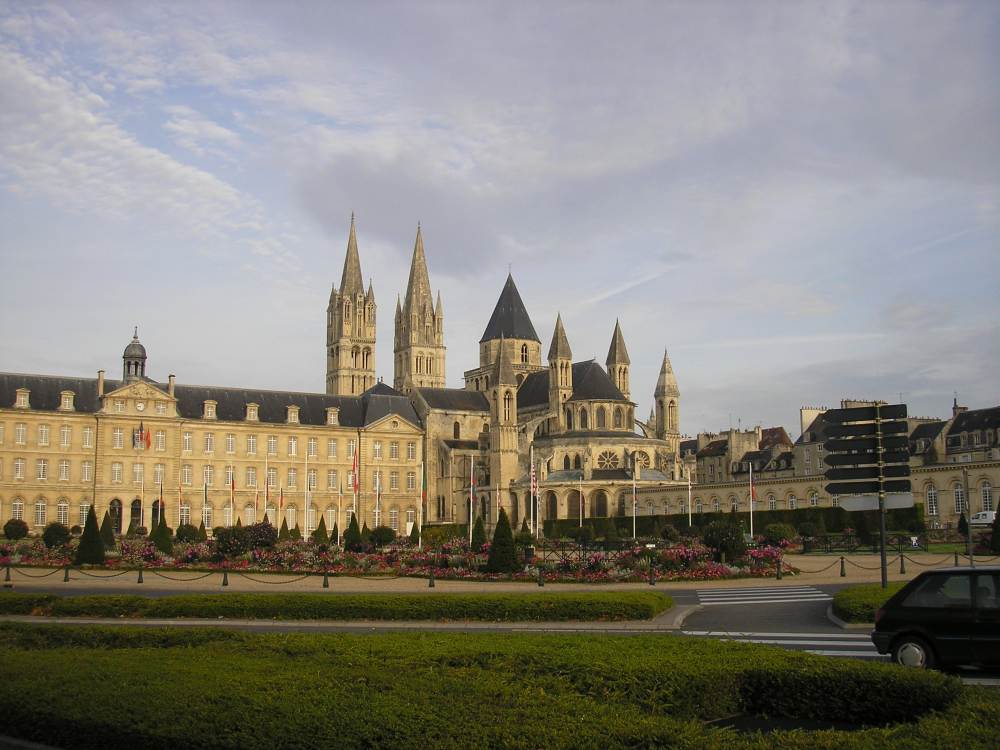Caen, Église Saint-Étienne
| Builder | A. Cavaille-Coll |
|---|---|
| Year | ca. 1885 |
| Period/Style | Romantic |
| Stops | 50 |
| Keyboards | 3+P |
| Keyaction | tracker/mechanical |
| Tuning | Equal at 440 Hz |
| Sampleset |
Available
 , sampled by
Sonus Paradisi
, sampled by
Sonus Paradisi
|
Since its foundation by William the Conqueror in 1066 (who was buried in the presbytery of the church) the "Abbaye aux Hommes" was the center of the education for the whole region and center of the musical life. It is very likely that since the very beginnings, the ceremonies were accompanied by organ. The chronicles mention the organ for the first time in the 14th century, however this instrument was destroyed by the Hugenots (1562) and not until 200 years later was it replaced. The builders of the new instrument were brothers Lefevre from Rouen. They enjoyed a similar reputation as their contemporaries Cliquot, Isnard or Moucherel. Master carpenter Gouy from Rouen built a monumental oak organ casework adorned by two Herculean statues, which support the pedal towers. The consecrating ceremony was on February 10, 1745. The organ had over 4000 pipes, 60 registers, 5 keyboards (three of them with 53 tones) and for that time unusual pedal board comprising 30 keys and 13 registers (including double trompette and clarion). The instrument survived without much harm during the revolutionary rampages. Just like with the organ in St. Maximin, playing Marseillaise at the right time was helpful in saving the organ. However, by the mid 19th century, the organ was practically unplayable due to its poor maintenance, its sheer size and mechanical complexity. Even a comprehensive reconstruction by Verschneider (1859-1863) did not help to change the sad situation. This led to the decision to obtain a new organ utilizing the perfectly preserved Gouy's casework still valued at 60 000 francs.
The negotiation with Aristide Cavaillé-Coll started in 1882 and he submitted 3 proposals: cleaning, repair of pipes and mechanical parts (8 850 Fr), or the same as before plus new mechanical parts with a pneumatic tracker action (15 600 Fr) or a complete new organ with the most modern design (60 000 Fr).
The agreement for a new instrument for 70 000 Fr was signed by Abbé Bréard and Cavaillé-Coll on April 6, 1882. Abbé Bréard contributed 30 000 Fr himself and parish collections covered the rest. Collaboration of Cavaillé-Coll with the church titulary organist Jules Marie and Alexander Guilmant led to the organ disposition outline. Jules Marie also wrote an official assessment of the previous historic organ. Josef Koenig, who also repaired the casework, succeeded the main intonator, Felix Reinsburg, in the final work. Also Charles Mutin, later a successor to Cavaillé-Coll, collaborated on the work. Alexander Guilmant inaugurated the organ in ceremony on March 3, 1885, in the presence of Cavaillé-Coll.
Despite unanimous recognition given to the new instrument, comments sprung up that the new organ sound was weak and indistinctive. Eventually, Cavaillé-Coll heard the comments and was astonished. He sent out a renowned organ expert, Philbert, to find out more. He discovered that the presence of a large audience can dramatically change the acoustics of the church. The old, sharply intonated, monumental organ with numerous mutation voices was replaced with a Romantic, symphonic instrument to which the parishioners and listeners were simply not prepared. The controversy quieted down over time and was forgotten. Josef Koenig, and his son Paul-Marie maintained the instrument until 1944. Electric power replaced the work of 4 calcants in 1928. Caen was heavily damaged during World War II, but by a miracle, the St. Etienne abbey was saved. Still, reconstruction of the organ was needed, which was performed by Jacquot-Lavergne company without substantial changes. The one exception was (by suggestion of Marcel Dupre) the addition of a mixture (Plein Jeu IV) in Recit. However, later in 1999 the register was once again removed. The last substantial reconstruction was finished in 2001 and returned the organ to its original form of 1885. Since 1975, the organ is listed as a national cultural heritage.
The negotiation with Aristide Cavaillé-Coll started in 1882 and he submitted 3 proposals: cleaning, repair of pipes and mechanical parts (8 850 Fr), or the same as before plus new mechanical parts with a pneumatic tracker action (15 600 Fr) or a complete new organ with the most modern design (60 000 Fr).
The agreement for a new instrument for 70 000 Fr was signed by Abbé Bréard and Cavaillé-Coll on April 6, 1882. Abbé Bréard contributed 30 000 Fr himself and parish collections covered the rest. Collaboration of Cavaillé-Coll with the church titulary organist Jules Marie and Alexander Guilmant led to the organ disposition outline. Jules Marie also wrote an official assessment of the previous historic organ. Josef Koenig, who also repaired the casework, succeeded the main intonator, Felix Reinsburg, in the final work. Also Charles Mutin, later a successor to Cavaillé-Coll, collaborated on the work. Alexander Guilmant inaugurated the organ in ceremony on March 3, 1885, in the presence of Cavaillé-Coll.
Despite unanimous recognition given to the new instrument, comments sprung up that the new organ sound was weak and indistinctive. Eventually, Cavaillé-Coll heard the comments and was astonished. He sent out a renowned organ expert, Philbert, to find out more. He discovered that the presence of a large audience can dramatically change the acoustics of the church. The old, sharply intonated, monumental organ with numerous mutation voices was replaced with a Romantic, symphonic instrument to which the parishioners and listeners were simply not prepared. The controversy quieted down over time and was forgotten. Josef Koenig, and his son Paul-Marie maintained the instrument until 1944. Electric power replaced the work of 4 calcants in 1928. Caen was heavily damaged during World War II, but by a miracle, the St. Etienne abbey was saved. Still, reconstruction of the organ was needed, which was performed by Jacquot-Lavergne company without substantial changes. The one exception was (by suggestion of Marcel Dupre) the addition of a mixture (Plein Jeu IV) in Recit. However, later in 1999 the register was once again removed. The last substantial reconstruction was finished in 2001 and returned the organ to its original form of 1885. Since 1975, the organ is listed as a national cultural heritage.
| Grand Orgue | Positif | Récit | Pédale |
|---|---|---|---|
| Montre 16 | Bourdon 16 | Quintaton 16 | Bourdon 32 |
| Bourdon 16 | Montre 8 | Diapason 8 | Soubasse 16 |
| Montre 8 | Salicional 8 | Viole de gambe 8 | Contrebasse 16 |
| Gambe 8 | Unda maris 8 | Voix céleste 8 | Grosse Flûte 8 |
| Bourdon 8 | Cor de nuit 8 | Flûte traver. 8 | Violoncelle 8 |
| Flûte harmon. 8 | Prestant 4 | Flûte octav. 4 | Bourdon doux 8 |
| Prestant 4 | Flûte douce 4 | Octavin 2 | Flûte 4 |
| Flûte octav. 4 | Carillon III | Cornet II-V | Bombarde 16 |
| Doublette 2 | Basson 16 | Bombarde 16 | Trompette 8 |
| Quinte 2 2/3 | Cromorne 8 | Trompette 8 | Clairon 4 |
| Cornet V | Trompette 8 | Basson-hautbois 8 | |
| Plein-Jeu VII | Clarinette 8 | ||
| Bombarde 16 | Voix humaine 8 | ||
| Trompette 8 | Clairon 4 | ||
| Clairon 4 |
Boellmann-Priere-Caen
0:00
0:00
1652801582-Camille Saint-Saens Marche Heroique Op. 34 arr. F. A. Guilmant
0:00
0:00
Boellmann-Toccata-Caen
0:00
0:00
Tournemire - Final
0:00
0:00
ornet2011-07-15-12-55-47CaenSurroundMainoutput
0:00
0:00
march2011-07-15-13-14-45CaenSurroundMainoutput
0:00
0:00
1384713264-Vierne Cathedrales Caen v2.5 kaal
0:00
0:00
https://www.sonusparadisi.cz/en/organs/france/caen-st-etienne.html
https://inventaire-des-orgues.fr/detail/orgue-caen-eglise-saint-etienne-fr-14118-caenn-stetie1-t/
https://inventaire-des-orgues.fr/detail/orgue-caen-eglise-saint-etienne-fr-14118-caenn-stetie1-t/
 Pipe Organ Map
Pipe Organ Map
